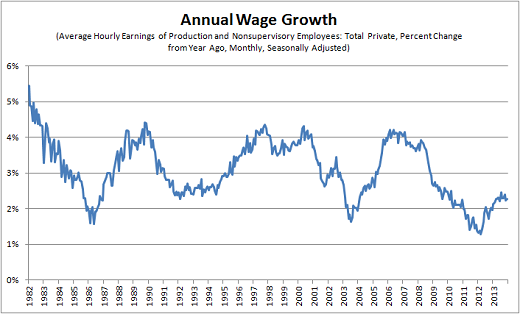Are wages finally ready to soar?
For most Americans, the economic "recovery" to date has lacked a critical ingredient. Corporate profitability has soared to record highs. The country's economic output has never been higher. The stock market has thrived.
The missing piece of the puzzle? Wages. Wage growth -- specifically, the year-over-year change in the hourly earnings of private production and nonsupervisory employees -- peaked at just above 4 percent before the housing crash, but then slid to a low of 1.3 percent in 2012. Since then, the measure has rebounded to a middling 2.3 percent, which means wages are only just keeping up with inflation.
The evidence suggests, however, that wages could be set to rise.
One important sign that workers could soon see their pay rise: Surveys of small businesses show rising demand for workers, with employers reporting that it's becoming harder to find qualified applicants. Managers expect wages to drift higher.
What will it take to get them there? A tightening of labor market conditions, which already seems to be happening.
By one measure of wages (of which there are many), they are already growing at levels not seen since early 2010. This is what's known as usual weekly earnings, and includes tips, overtime, commissions and other sources of income missed in alternative measures of pay. This is an important clue because it's the only main wage indicator that is reported from the employee perspective (It comes from a survey of a roughly a quarter of the 15,000 households that the U.S. Labor Department asks every month about their employment status.)
Another measure, which focuses on companies, is known as the Employer Costs for Employee Compensation or ECEC. This measures the cost of wages and salaries, benefits and incentives. Last month, the ECEC expanded at a pace not seen since late 2009.
When looking at the demand for labor, the Manpower hiring intentions index has increased to a six-year high and is set to finally return to pre-recession levels.
As for the supply of labor, it's worth mentioning that the short-term unemployment rate has fallen down near lows seen in the last two business cycles. Moreover, Gluskin Sheff economist David Rosenberg notes that a measure known as the Available Labor Supply, calculated by the Bureau of Labor Statistics, has fallen to its lowest level in six years, to 15.6 million people. Over the last year, the measure has dropped 15 percent, which amounts to 2.7 million workers.
Although higher wages will eat into corporate profits in the short-term, it's just the thing the wider economy needs to shift up a gear, become less dependent on cheap money stimulus, and help American households fully participate in the recovery.

